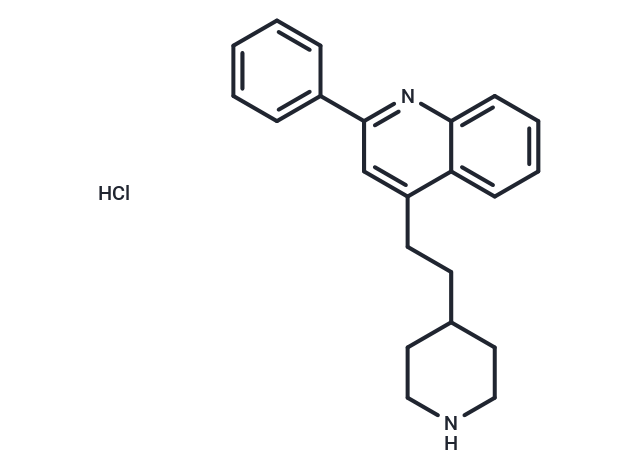Shopping Cart
- Remove All
 Your shopping cart is currently empty
Your shopping cart is currently empty

Pipequaline hydrochloride (PK-8165 hydrochloride) is an anticonflict and anticonvulsant quinoline derivative and an anxiolytic drug that was never marketed. It possesses a novel chemical structure, not closely related to other drugs of this type, with a pharmacological profile similar to benzodiazepines but predominantly anxiolytic, exhibiting minimal sedative, amnestic, or anticonvulsant effects, thus classified as a nonbenzodiazepine anxiolytic.

| Pack Size | Price | Availability | Quantity |
|---|---|---|---|
| 1 mg | $41 | In Stock | |
| 5 mg | $90 | In Stock | |
| 10 mg | $132 | In Stock | |
| 25 mg | $228 | In Stock | |
| 50 mg | $360 | In Stock | |
| 100 mg | $540 | In Stock |
| Description | Pipequaline hydrochloride (PK-8165 hydrochloride) is an anticonflict and anticonvulsant quinoline derivative and an anxiolytic drug that was never marketed. It possesses a novel chemical structure, not closely related to other drugs of this type, with a pharmacological profile similar to benzodiazepines but predominantly anxiolytic, exhibiting minimal sedative, amnestic, or anticonvulsant effects, thus classified as a nonbenzodiazepine anxiolytic. |
| In vitro | Pipequaline is extensively bound to plasma proteins: i.e. human serum albumin (HSA), alpha-1-acid glycoprotein (AAG), lipoproteins and blood cells, mainly erythrocytes[1]. |
| In vivo | Intravenously administered pipequaline exerts a partial suppression of activations by kainate, glutamate and acetylcholine. Microiontophoretic applications of pipequaline reduces the neuronal activation by kainate[2]. Pipequaline produces dose-related decreases in motor activity. Pipequaline produces significant dose-related decreases in the number of head-dips made[3]. |
| Animal Research | Rats: Pipequaline is dissolved in water to give injection volumes of 2 mL/kg. Rats are injected with 5, 10, and 50 mg/kg pipequaline. Infrared cells in the walls of the box provided automated measures of locomotor activity and rearing, respectively[3]. |
| Alias | PK-8165 hydrochloride |
| Molecular Weight | 352.9 |
| Formula | C22H25ClN2 |
| Cas No. | 80221-58-5 |
| Smiles | Cl.C(Cc1cc(nc2ccccc12)-c1ccccc1)C1CCNCC1 |
| Relative Density. | no data available |
| Storage | Powder: -20°C for 3 years | In solvent: -80°C for 1 year | Shipping with blue ice. | ||||||||||||||||||||||||||||||
| Solubility Information | DMSO: >30 mg/mL (94.8 mM), Sonication is recommended. | ||||||||||||||||||||||||||||||
Solution Preparation Table | |||||||||||||||||||||||||||||||
DMSO
| |||||||||||||||||||||||||||||||

Copyright © 2015-2025 TargetMol Chemicals Inc. All Rights Reserved.